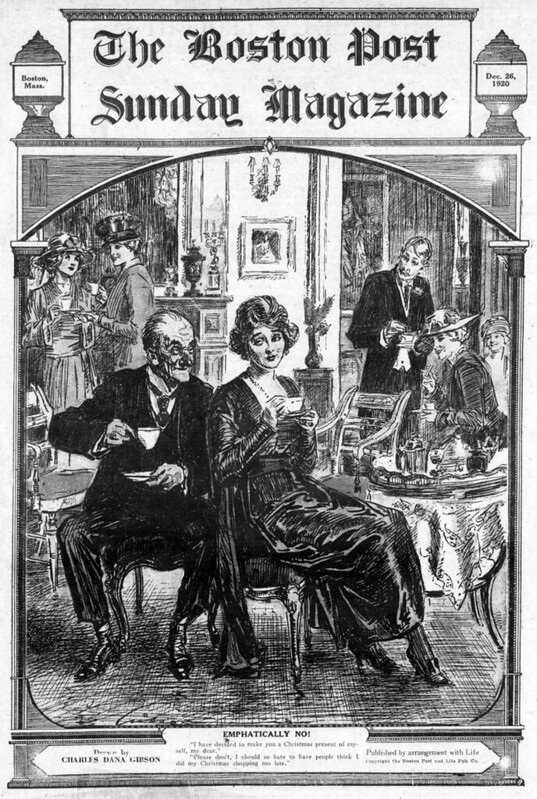christmas 1920: merry christmas to you from the boston post
Masthead, Boston Post, December 25, 1920. Click on image for larger version.
While scrolling through papers for this series, the illustrations published by the Boston Post stood out in terms of quality and variety. It feels like they put extra effort in gathering material from sources ranging from already published prints to popular humour magazines.
With this lush masthead as our entrance, let's explore what was in the Post's holiday editions.
Christmas 1920! It will be a day of joy and gladness in Boston.Out of the chaos of the world worries it will dawn filled with good cheer for rich and poor alike, for those that are well and those that are ill, for everyone in all walks of life it will be a wondrous day, for never have the people of Boston asked for so much or never has the response so generous.Thousands of bountiful dinners will be distributed, shoes for the needy, warm clothing, cheer for the sick - even the horses were not forgotten.
Side by side: some lines from 19th century poet Henry Wadsworth Longfellow, and an ongoing series spotlighting "Famous Cats of New England" - further proof that the internet didn't invent cat-related content.
Boston Post, December 25, 1920. Click on image for larger version.
How many children in 1920 found copies of this map under the Christmas tree? Those who did may have been entranced by the way it ties together all kinds of well-known stories, mythologies, and legends.
The British Library describes Bernard Sleigh's An Ancient Mappe of Fairyland as depicting "a place loosely defined as one of fantasy, literary imagination and make-believe. It is a bird’s-eye view of an island with extraordinary topography, populated with a complete range of myth, fable, legend, nursery rhyme, children’s story, play and poem."
The three-sheet version was originally published in England in 1918, with a smaller, single sheet edition released around 1920.
The gorgeous, full-colour version can be found in numerous places online, from Atlas Obscura to the Library of Congress.
Boston Post, December 25, 1920. Click on image for larger version.
The sports page was topped with this cartoon, split between Santa delivering gifts, and a grumpy old man who knows the cost of everything and the value of nothing.
Boston Post, December 26, 1920.
Given the high volume of Christmas-related content inside the December 26 edition of the Post's Sunday magazine, I wonder if Christmas was a two-day affair in Boston. Maybe the paper realized readers wouldn't fully enjoy holiday-themed content until the following day, once presents were opened and dinners were digested.
The front page of this section spotlights the art of Charles Dana Gibson, whose "Gibson Girl" illustrations became an iconic representation of beauty as the 19th century gave way to the 20th. This piece was sourced from the original Life magazine, a humour publication whose name was bought by Henry Luce in 1936 for his photojournalism weekly.
Part of the room was clear to our view, though about half of it was shut off from us by the very king of all Christmas trees, glittering with dozens and dozens of candles, sumptuous in silver, sparkling in gold, and laden with Heaven alone knows how many and what delectable enticements. Opposite the tree, his back against the wall, sat old Bob, clad in a dress of state, part of which consisted of a swallow-tail coat (with an overgrown chrysanthemum in the buttonhole), a red necktiee, and a pink-and-silver liberty cap of tissue paper. He was scraping a fiddle "like old times come again," and the tune he played was "Oh my Liza, Po' Gal!" My feet shuffled to it in the snow.No one except old Bob was to be seen in the room, but we watched him and listened breathlessly. When he finished "Liza," he laid the fiddle across his knee, wiped his face with a new and brilliant blue silk handkerchief, and said: "Now comes the big speech."










Comments